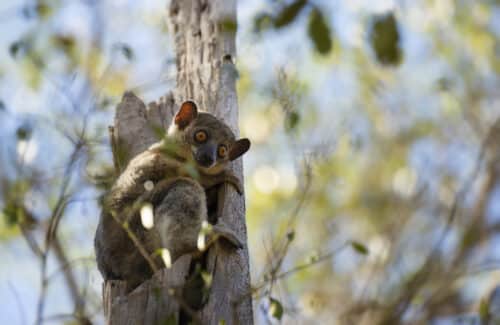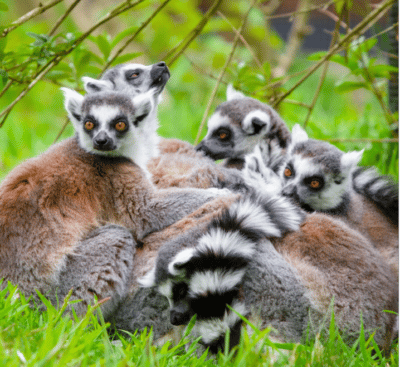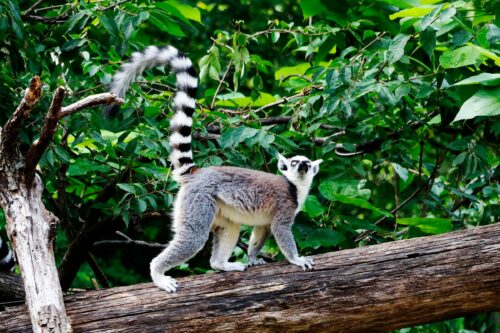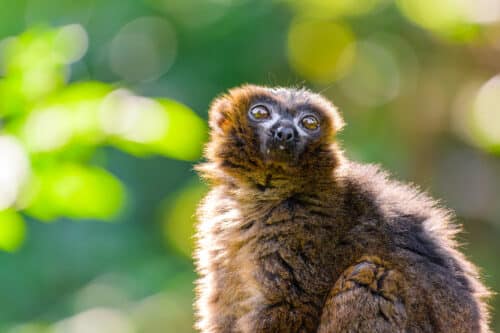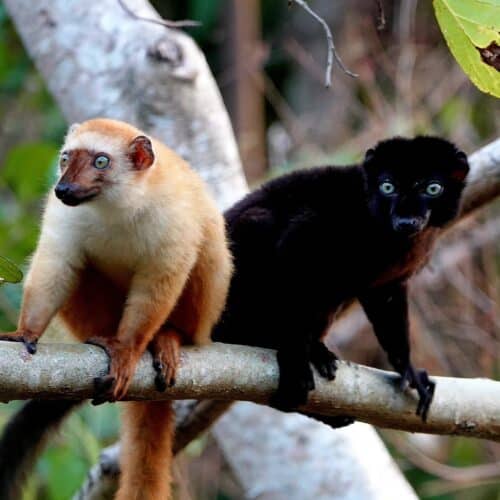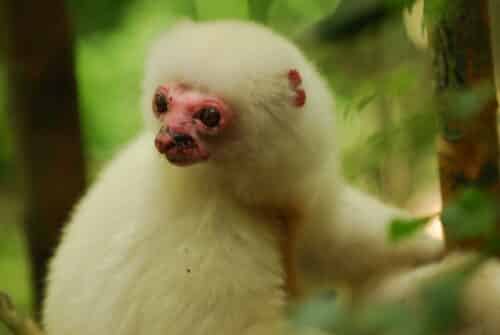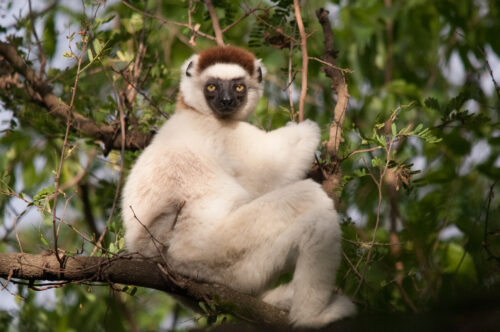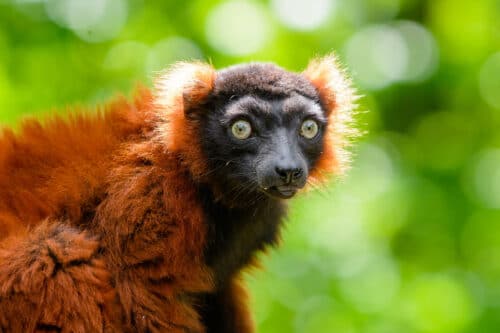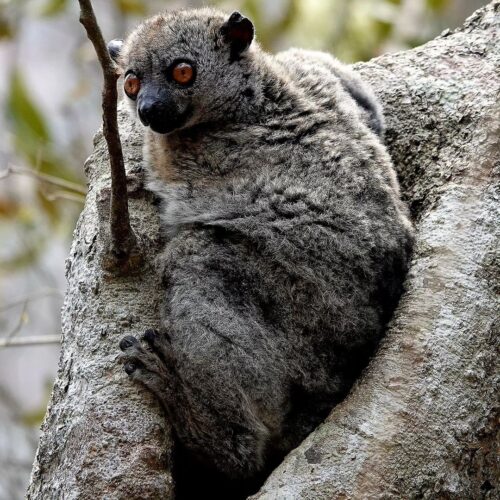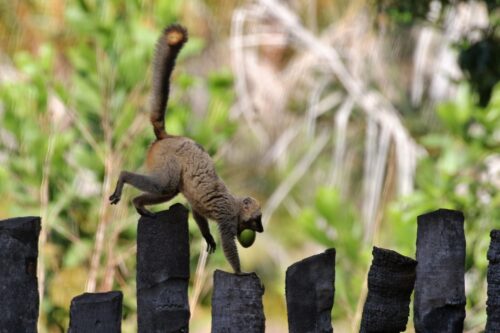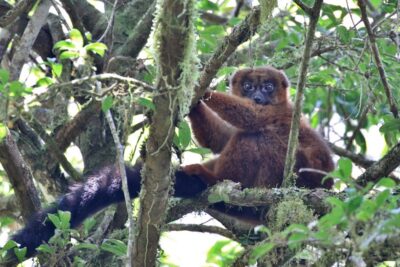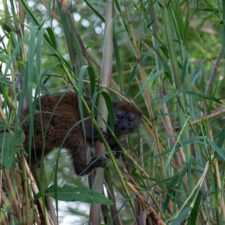For the last year, our #FunFactFriday posts on social media have been some of our most popular! In this blog post, we share some of the highlights. Learn about lemur behavior, sexual dimorphism, unique features, and food.
Follow the Lemur Conservation Network on Facebook and Instagram to find new fun facts every Friday!
Behavior
Red-tailed sportive lemurs take monogamy to a whole new level!
These lemur couples share a home range but don’t participate in bonding interactions outside of mating season. Talk about keeping it strictly business!
📷: Samuel DeRycke
Ever wondered why ring-tailed lemurs love to snuggle up in groups?
It’s not just about cuddles! These intelligent lemurs huddle together for warmth during chilly nights in Madagascar. Plus, it’s a way to reinforce social bonds and maintain their unique troop dynamics!
Ring-tailed Lemur Fact Sheet📷: Mathias Appel
Did you know ring-tailed lemurs have a sophisticated communication system?
From scent marking to visual displays, they ensure effective group coordination and threat detection. They keep their troops in sync with raised tails, acting like flags to signal group cohesion during travel.
📷: Amy Reed via Unsplash
Sexual Dimorphism
Did you know that male and female red-bellied lemurs look different from each other?
This is called sexual dichromatism. Adult females have a large cream-colored patch on their bellies and adult males have white patches under their eyes resembling teardrops.
Red-bellied Lemur Fact Sheet📷: Mathias Appel
How can these lemurs be the same species? They are sexually dimorphic, that’s how! Female blue-eyed black lemurs aren’t black at all!
These blue-eyed beauties live only in and around Sahamalaza Iles Radama National Park in northwest Madagascar! They are quite rare, but Mikajy Natiora is one organization that is determined to protect them.
This Malagasy-run NGO protects Madagascar’s endemic biodiversity by combining ecological research and local community involvement. Mikajy Natiora always informs local communities when they are going to conduct activities in the vicinity by using public meetings to explain the objectives of their work. They also have several education and outreach programs that supplement their research-based approach.
📷: Deb Bradley
Unique Features
Check out that tooth comb! 🦷
Ring-tailed lemurs use the specialized teeth on the bottom of their mouths to help groom themselves and others. No excuse for matted fur when your comb is part of your body!
📷: Martin Brechtl on Unsplash
Why do silky sifakas have pink skin?
While early explorers believed they were albinos, this is not true. In fact, their skin depigments rapidly with age, perhaps more than other primate in the world. All individuals are born with black faces, and lose their skin pigment all over their body (not just the face) as they age.
📷: Simponafotsy
Did you know that Verreaux’s sifakas inhabit a diverse range of habitats, from tropical dry forests to humid lowland forests? Their adaptability is truly remarkable! 🍃
Juvenile Verreaux’s sifakas are a sight to behold, with their striking all-white fur adorned with a dark brown spot on the crown and occasional rufous hues underneath. But here’s the fascinating part: there’s variation in their appearance! Some sport mainly white coats, while others boast maroon patches on their backs, bellies, or limbs. Nature’s palette truly knows no bounds!
📷: William Stephens, Creative Commons Attribution 4.0
Food
Red Ruffed Lemurs are major fruit lovers, with fruit making up a whopping 75-95% of their diet!
But it’s not just fruit that red-lemurs adore—they’re also big fans of nectar! With their long noses, they eagerly dive into flowers to sip on sweet nectar, becoming important pollinators in Madagascar’s tropical forests.
📷: Mathias Appel
The Daraina sportive lemur is one of over 25 types of sportive lemurs!
These nocturnal lemurs live in a small area in northern Madagascar. Most sportive lemurs are folivorous which means they eat leaves! 🍃
📷: Deb Bradley
Did you know some lemurs change their diet based on the season?
In the dry season, red-fronted brown lemurs will eat leaves. But when the weather is right, their diet consists of flowers and their favorite snack — fruit!
📷: Cat Rayner
Did you know some lemurs supplement their diet with mushrooms and tree bark?!
Red-bellied lemurs are frugivorous, but will supplement their diet with leaves, nectar from flowers, and even insects, mushrooms, and tree bark! 🍃 🌸 🪲 🍄 🌳
📷: Cat Rayner
Follow the Lemur Conservation Network on Facebook and Instagram to find fun facts about lemurs and absolutely adorable lemur photos!
Some of our most popular hashtags include #FunFactFridays, #TongueOutTuesday, and #SundaysAreForSnuggles — don’t miss our photos of lemurs in all their glory. And, find updates about conservation work on the ground in Madagascar, the latest research in conservation science, and how you how you can help these fascinating primates.

